Artificial Intelligence (AI) has revolutionized point-of-sale management with more effective and faster Image Recognition (IR) solutions. However, the success of these solutions depends not only on the IR technology itself but also on the proper integration of this technology within the retail environment.
Keys to Successful Implementation of Image Recognition (IR) in Retail
At Xpuntocero, we have developed extensive expertise in this area and would like to share 9 key tips for successful implementation.
1. Consideration of Retail Conditions
The solution integrating IR must take into account all the circumstances and conditions encountered by a POS Manager (Point of Sale Manager) when taking a photo of a shelf. It is crucial to ensure a successful user experience by keeping the POS Manager informed at all times about the current status of the process and the results obtained.
2. Learning Process for POS Managers
IR involves a learning process for POS Managers in taking photographs. It is essential to follow specific guidelines to achieve good results. The better the photos, the better the results.

3. Organizational Commitment
The success of the IR project requires the commitment of the entire retail organization, both during the project launch phase and in the maintenance of the database. The adopted solution should automate processes for optimal database maintenance.
4. Management of External Factors
The adopted solution must consider how to manage external factors that affect the quality of photographs, providing alternatives to address such situations, for example, low-definition price tags.
5. Connectivity and Manual Audits
Connectivity in retail locations is not always reliable and sometimes nonexistent. In these circumstances, the solution should allow for manual audits or the use of IR at a later time.
6. Measuring and Quantifying Accuracy
Measuring and quantifying the accuracy of IR is essential. Defining specific KPIs allows for the evaluation and improvement of each POS Manager’s performance. What gets measured gets improved.

7. Comparing Results
When comparing results between a shelf audit with and without IR, it is important to do so under the same conditions, that is, by collecting and checking the same information. If done correctly, the time saved is at least 20%, increasing as larger shelves are addressed.
8. Clarity of Objectives
As with any project, it is crucial to have clear objectives from the start. These objectives can vary by company: more information, less time collecting data, more reliable and objective information. Having clear objectives allows for better evaluation of the results obtained.

9. Visibility and Reporting
Having a good reporting system is crucial for clear visibility of the results obtained. An effective reporting system provides quick and easy information for decision-making.
Conclusion
Implementing an Image Recognition (IR) solution in your company can be a transformative project.
If you are considering undertaking such a project, we hope these tips have been helpful.
At Xpuntocero, we are experts in point-of-sale management solutions and would be delighted to learn about your project and assist in its development and implementation.
Román Jané
CEO at Xpuntocero
Would you like to learn more about how Image Recognition can transform your point-of-sale management? Contact us for more information or to request a demo.
You can learn more about our IR app in this video.